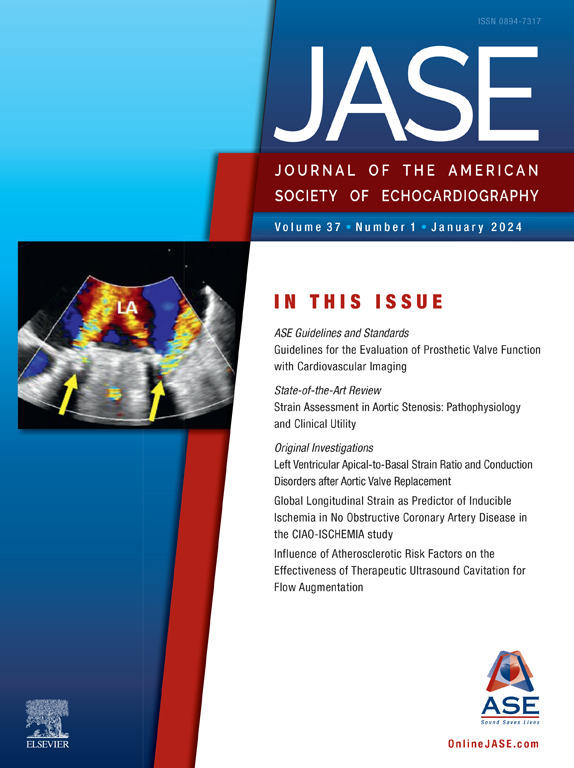丰坦循环的收缩功能可通过运动恢复,但不可通过前负荷恢复。
IF 5.4
2区 医学
Q1 CARDIAC & CARDIOVASCULAR SYSTEMS
Journal of the American Society of Echocardiography
Pub Date : 2025-04-01
DOI:10.1016/j.echo.2024.11.005
引用次数: 0
摘要
背景:丰唐循环衰竭伴有收缩功能受损的情况已被充分证实,但其机制尚未完全明了。我们旨在探讨丰坦循环青少年患者的心肌功能储备对运动或急性前负荷增加的反应:我们的研究包括 32 名丰坦循环患者(中位年龄:16.7 岁,范围:15.4-17.9 岁,女性 12 名)。超声心动图成像是在使用仰卧位循环测力计运动时进行的,以及在快速输注0.9%生理盐水(5 mL/kg体重)的心导管检查过程中进行的。我们测量了运动前、运动中和运动后特定时间间隔内的四腔心肌峰值纵向应变(LS)(LSstress)和容量负荷(LScath)。在导管插入过程中,同时记录中心静脉压(CVP)和心室舒张末期压(VEDP)。由 16 名健康人组成的对照组参加了运动测试:结果:患者的平均 LSstress 负值低于对照组(所有阶段的 P 均≤0.001);但是,患者的 LSstress 负值从基线时的(-18.4±5.5%)显著提高到最大负荷时的(-22.0±6.5%)(P=0.004)。最大负荷时的 LSstress 与心率变化无关。在导管插入过程中,基线时的平均 LScath 为 -19.6±6.0%,在注入生理盐水后的 1.00-2.00 分钟和 4.00-6.00 分钟内没有明显改善。一半以上的患者在输注生理盐水后,LScath 的恶化或改善幅度低于-2%。在所有情况下,LScath 的恶化都与 CVP 和 VEDP 相关(P≤0.017)。形态学右心室和形态学左心室的LSstress或LScath没有差异:结论:丰坦循环患者表现出收缩期心肌功能储备,可在运动应激时被招募,但不能在前负荷急性增加时被招募。本文章由计算机程序翻译,如有差异,请以英文原文为准。
Systolic Function in the Fontan Circulation Is Exercise, but Not Preload, Recruitable
Background
Fontan circulatory failure with impaired systolic function is well documented; however, its mechanisms are not fully understood. The aim of this study was to explore myocardial functional reserve in adolescent patients with Fontan circulation in response to exercise or acute preload increase.
Methods
The study included 32 patients (median age, 16.7 years; range, 15.4–17.9 years; 12 female patients) with Fontan circulation. Echocardiographic imaging was performed during exercise using a recumbent cycle ergometer and during heart catheterization with a rapid infusion of 0.9% saline infusion at 5 mL/kg body weight. Myocardial peak longitudinal strain (LS) was measured in a four-chamber view during specific time intervals before, during, and after exercise (LSstress) and volume load (LScath). During catheterization, central venous pressure and ventricular end-diastolic pressure were simultaneously recorded. A control group of 16 healthy individuals participated in the exercise test.
Results
Mean LSstress was less negative for patients than for control subjects (P ≤ .001 at all stages); however, it significantly improved from −18.4 ± 5.5% at baseline to −22.0 ± 6.5% (P = .004) at maximal loading. LSstress at maximal loading did not correlate with changes in heart rate. During catheterization, mean LScath was −19.6 ± 6.0% at baseline and did not improve significantly at 1.00 to 2.00 minutes and at 4.00 to 6.00 minutes after saline infusion. In more than half of the patients, LScath worsened or improved by less than −2% after saline infusion. Worsening of LScath correlated with central venous pressure and ventricular end-diastolic pressure in all conditions (P ≤ .017). There was no difference in LSstress or LScath between the morphologic right ventricle and the morphologic left ventricle.
Conclusions
Patients with Fontan circulation demonstrate systolic myocardial functional reserve that can be recruited with exercise stress but not with an acute increase in preload.
求助全文
通过发布文献求助,成功后即可免费获取论文全文。
去求助
来源期刊
CiteScore
9.50
自引率
12.30%
发文量
257
审稿时长
66 days
期刊介绍:
The Journal of the American Society of Echocardiography(JASE) brings physicians and sonographers peer-reviewed original investigations and state-of-the-art review articles that cover conventional clinical applications of cardiovascular ultrasound, as well as newer techniques with emerging clinical applications. These include three-dimensional echocardiography, strain and strain rate methods for evaluating cardiac mechanics and interventional applications.

 求助内容:
求助内容: 应助结果提醒方式:
应助结果提醒方式:


